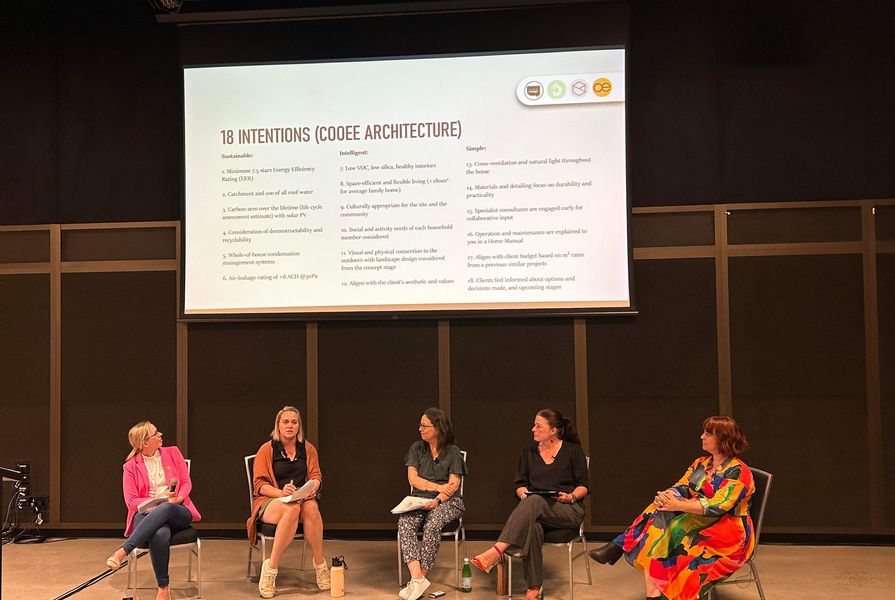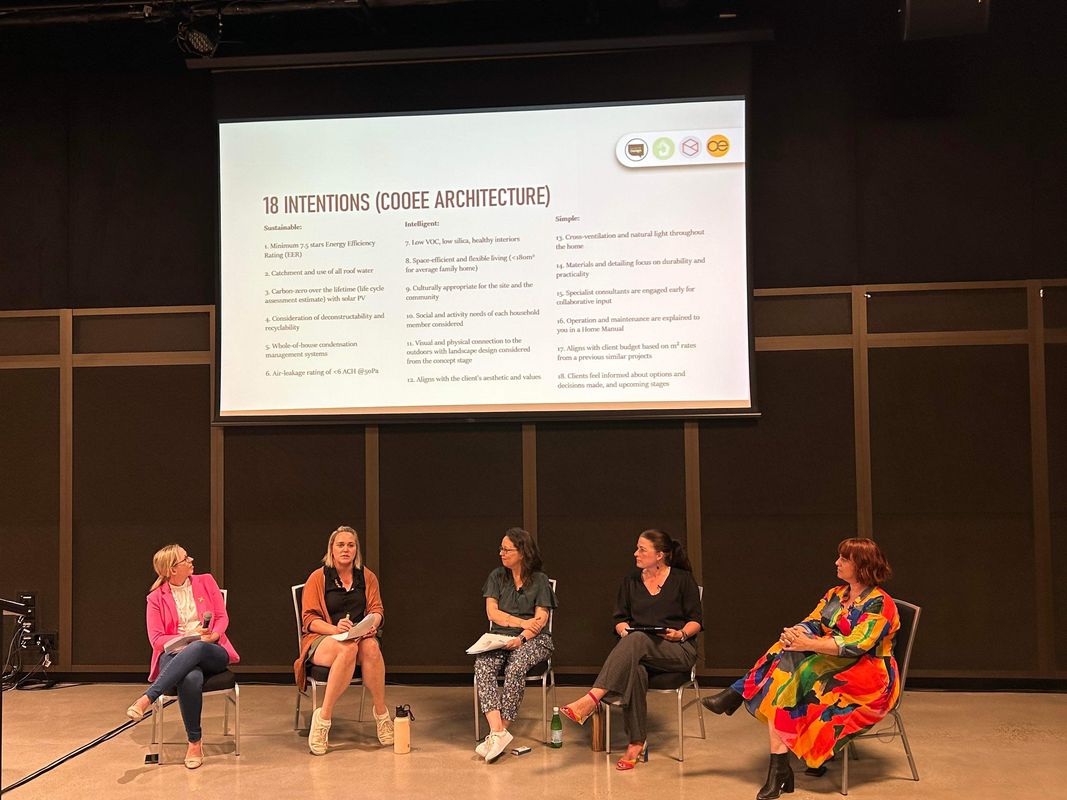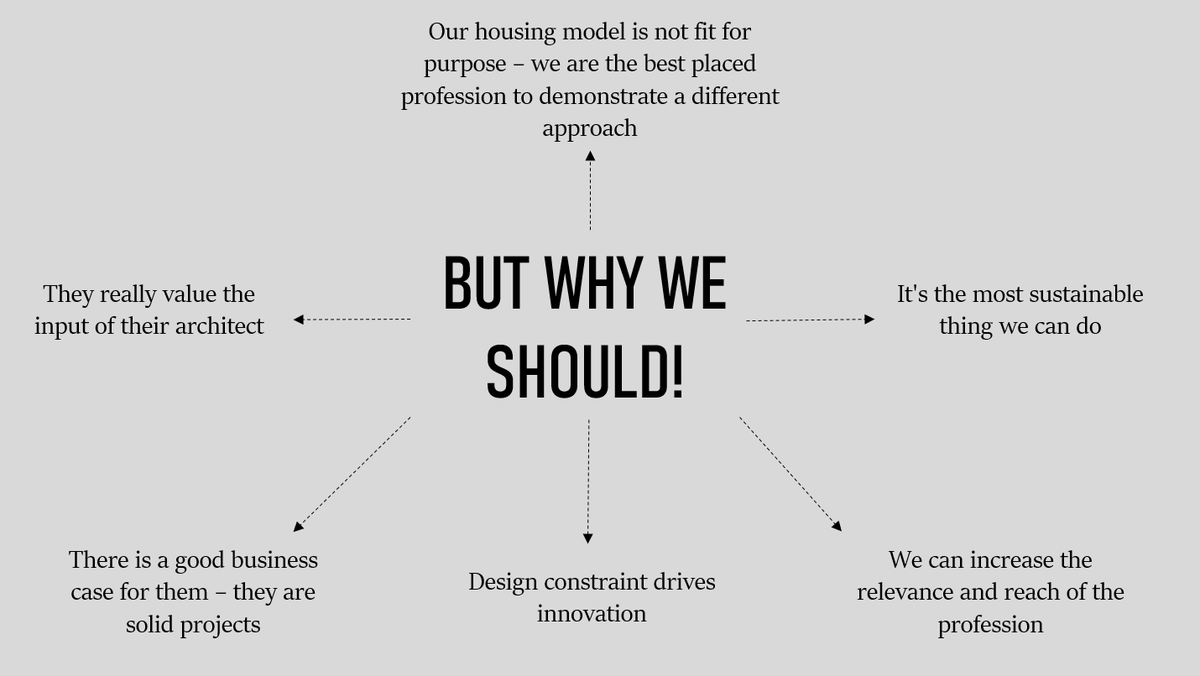An architect, an entrepreneur and a journalist walk onto a stage … what do you think they’re going to discuss?
The effectiveness and impact of architecture.
When the call came out for proposals to present at the 2023 Australian Architecture Conference, in a flash of inspiration, I knew exactly which three people I wanted to bring together for a discussion: Rachael Bernstone (Sounds Like Design), who helps architects better evidence their value for wider reach; Amelia Lee (Undercover Architect), who is redefining the impact a single architect can have by educating thousands of homeowners through audio content and courses; and Rebecca Caldwell (Maytree Studios), who is generously pulling back the curtain on what a healthy architecture business looks like, and how it can increase public accessibility to architecture in the single-residential market.
We titled it “What are we practising for?” and in providing our own answers to that question, we surmized that while all architects generally mean well and intend to solve tricky problems to create positive change in the world, our impact is a fraction of what it could (or should) be, and that we absolutely have the power to change this. Indeed, we have an obligation to the world, to change this.
So what are we getting wrong?
Firstly, Rachael explained that our messaging, marketing, and even advocacy isn’t cutting through to the right people. Amelia, who had asked her army of fans what they wanted architects to know, reported that the public don’t have a common definition of design, or what it means to work with an architect, and that they are desperate for good guidance through the process, especially in managing their budgets. Amelia also pointed out that social media means that we’re battling these challenges while also serving clients who are no longer seeking to “keep up with the Joneses” but are instead aspiring to “keep up with the Kardashians.”
Bec, who candidly compares her first failed business with her current thriving one explains that the “default mode” of new practice is unsustainable, unprofitable and unable to serve the kind of people she wanted to help. Like many new practices, she believed that the trifecta of beautiful project, nice client and profitable fees was unrealistic, and that one would always be sacrificed. This common mindset creates an environment where we become trapped in a workplace that defines us. By flipping this mindset, seeing herself as a business manager, systemizing the broad set of skills architects offer in a way that served her ideal client, Bec drastically changed the narrative. Importantly, this method doesn’t require big, expensive budgets to work, and Maytree can focus on the smaller, meaningful work that they love. Bec introduced the following two slides, pointing out why most firms don’t take on smaller projects and why we should turn that belief around.
Rebeccan Caldwell on why most firms don’t take on smaller projects and why we should turn that belief around.
Image: Courtesy Sarah Lebner
Rebeccan Caldwell on why most firms don’t take on smaller projects and why we should turn that belief around.
Image: Courtesy Sarah Lebner
As I listened to my fellow panellists, it occurred to me that many of our faults are driven by fear. At university we’re conditioned to fear the opinions of our assessors and we carry that into our professional lives, constantly seeking approval from peers and forgetting that we should instead direct our skills to the public, in their own language. We fear putting ourselves out there so we don’t engage a lot in public education about the knowledge we have to offer. We fear that a builder will complicate the design process so we don’t get them involved until everything is perfectly resolved. We fear having our fees undercut so we don’t charge in a way that gives us freedom to build better systems, standards and offerings.
How do we move beyond that fear? How do we go back to our desks and tackle some of these propositions? I believe the four of us summarized four very actionable points.
From Rachael, we learned to reflect on our service and contemplate whether it is a “painkiller,” “vaccine,” “vitamin,” or “candy.” We need to recognize the ultimate value of the problem we are solving and then speak directly to our ideal client about this.
Rachael Bernstone on recognizing the ultimate value of the problem being solved
Image: Courtesy Sarah Lebner
From Amelia, we were inspired to think about educating our clients. It’s much easier to think about sharing our knowledge than drafting a marketing strategy, yet both are one and the same. We can also consider alternate forms of business, adding resources, workshops, courses, short-form consulting to our modes of service.
Bec listed a multitude of tactics used by Maytree to address these problems, such providing cost advice and a “budget warning rating” at every meeting, creating a new system or information document each time a challenge or lack of knowledge arose, running short format “winter warmers” and “summer sessions” of short one-on-one consultations with architects to open up the access, and working towards an employee ownership model to foster an invested and fulfilled team.
And from myself, I shared Cooee Architecture’s 18 Intentions. These are goals that we strive towards on every project and wherever we don’t meet them, we must justify it with good reasons. It’s been a game changer for our clients who, at first, are wondering “what do I get out of hiring you for this process?” They instead contact me with palpable relief and excitement that I’m on the same page as they are and can deliver what they want. I would argue that any kind of practice could create a similar list of typical outcomes, even if they have a vastly different focus or expertise to myself.
Cooee Architecture’s 18 intentions.
Image: Courtesy Sarah Lebner
As our time slot quickly came to an end, there was a question on my list that I didn’t get a chance to ask. Does architecture (and construction) have an efficiency problem? I knew what the answers my fellow panellists would give. Rachael would report that a significant portion of architect-designed projects are never realized, with anecdotal estimates of 27 percent and even 80 percent. Amelia would explain that bringing the builder in after all the decisions are made can result in misunderstood, substitution and reactionary cost saving. Bec would share that outdated attitudes to running a practice result in high staff turnover, confused clients and reinventing the wheel time and time again. I would add that through my work with myfirstarchitecturejob.com that I hear time and time again how frustrated aspiring architects are by the barriers to learning good practice, good business and good technical knowledge.
Imagine if we could address these inefficiencies. Imagine if we could also do it while running our businesses more effectively, innovatively, and joyfully. And goodness, imagine if we could start to be involved with, or contribute to, more than just 5 to 10 percent of single residential projects.
It seems to me there’s a lot of low hanging fruit here.
My friends, it’s time to make some fruit salad.
























